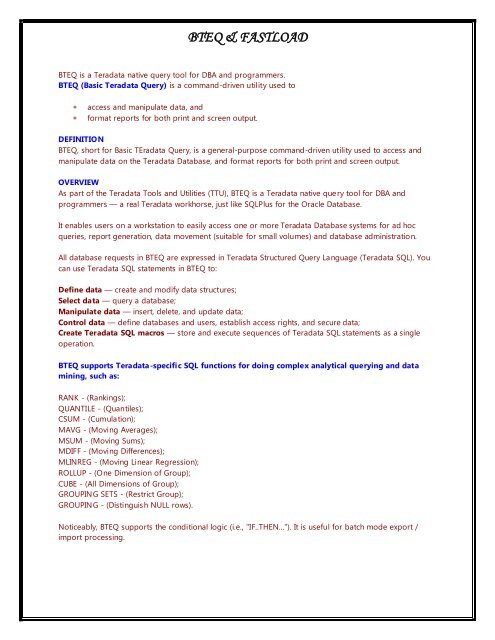15.10 - Teradata FastLoad Utility - FastLoad Teradata FastLoad Reference prodname FastLoad vrmrelease 15.10 category Programming Reference featnum B035-2411-035K. Teradata Online Documentation Quick access to technical manuals Find Teradata documentation—all online! Search Teradata's technical publications and explore our user guides, configuration guides, SQL manuals, and more. Sitemap Legal Support Policies Product Safety Careers Trademarks. Teradata FastLoad processes a series of Teradata FastLoad commands and Teradata SQL statements entered either interactively or in batch mode. Use the Teradata FastLoad commands for session control and data handling of the data transfers. The Teradata SQL statements create, maintain, and drop tables on the Teradata Database. Please visit Teradata Documentation for the latest technical publications, user guides, and reference manuals, including PDFs. For more information, see Teradata FastLoad Reference documentation. TStatCatcher Statistics. Select this check box to collect log data at the component level. This component offers the flexibility of the DB query and covers all possible SQL queries.
- Teradata Tutorial

- Teradata Basics
Online Reference Manual
- Teradata Advanced
- Teradata Useful Resources
- Selected Reading
FastLoad utility is used to load data into empty tables. Since it does not use transient journals, data can be loaded quickly. It doesn't load duplicate rows even if the target table is a MULTISET table.

Limitation
Teradata Fastload Tutorial
Target table should not have secondary index, join index and foreign key reference.
How FastLoad Works
FastLoad is executed in two phases.
Phase 1
The Parsing engines read the records from the input file and sends a block to each AMP.
Each AMP stores the blocks of records.
Then AMPs hash each record and redistribute them to the correct AMP.
At the end of Phase 1, each AMP has its rows but they are not in row hash sequence.
Phase 2
Phase 2 starts when FastLoad receives the END LOADING statement.
Each AMP sorts the records on row hash and writes them to the disk.
Locks on the target table is released and the error tables are dropped.
Example
Create a text file with the following records and name the file as employee.txt.
Following is a sample FastLoad script to load the above file into Employee_Stg table.
Executing a FastLoad Script
Once the input file employee.txt is created and the FastLoad script is named as EmployeeLoad.fl, you can run the FastLoad script using the following command in UNIX and Windows.
Once the above command is executed, the FastLoad script will run and produce the log. In the log, you can see the number of records processed by FastLoad and status code.
FastLoad Terms
Following is the list of common terms used in FastLoad script.
LOGON − Logs into Teradata and initiates one or more sessions.
DATABASE − Sets the default database.
BEGIN LOADING − Identifies the table to be loaded.
ERRORFILES − Identifies the 2 error tables that needs to be created/updated.
CHECKPOINT − Defines when to take checkpoint.
SET RECORD − Specifies if the input file format is formatted, binary, text or unformatted.
DEFINE − Defines the input file layout.
FILE − Specifies the input file name and path.
INSERT − Inserts the records from the input file into the target table.
END LOADING − Initiates phase 2 of the FastLoad. Distributes the records into the target table.
LOGOFF − Ends all sessions and terminates FastLoad.
- Teradata Tutorial
- Teradata Basics
- Teradata Advanced
- Teradata Useful Resources
- Selected Reading
FastLoad utility is used to load data into empty tables. Since it does not use transient journals, data can be loaded quickly. It doesn't load duplicate rows even if the target table is a MULTISET table.
Limitation
Target table should not have secondary index, join index and foreign key reference.
How FastLoad Works
FastLoad is executed in two phases.
Phase 1
The Parsing engines read the records from the input file and sends a block to each AMP.
Each AMP stores the blocks of records.
Then AMPs hash each record and redistribute them to the correct AMP.
At the end of Phase 1, each AMP has its rows but they are not in row hash sequence.
Phase 2
Phase 2 starts when FastLoad receives the END LOADING statement.
Each AMP sorts the records on row hash and writes them to the disk.
Locks on the target table is released and the error tables are dropped.
Example
Create a text file with the following records and name the file as employee.txt.
Following is a sample FastLoad script to load the above file into Employee_Stg table.

Executing a FastLoad Script
Once the input file employee.txt is created and the FastLoad script is named as EmployeeLoad.fl, you can run the FastLoad script using the following command in UNIX and Windows.
Once the above command is executed, the FastLoad script will run and produce the log. In the log, you can see the number of records processed by FastLoad and status code.
FastLoad Terms
Following is the list of common terms used in FastLoad script.
LOGON − Logs into Teradata and initiates one or more sessions.
DATABASE − Sets the default database.
BEGIN LOADING − Identifies the table to be loaded.
ERRORFILES − Identifies the 2 error tables that needs to be created/updated.
CHECKPOINT − Defines when to take checkpoint.
SET RECORD − Specifies if the input file format is formatted, binary, text or unformatted.
DEFINE − Defines the input file layout.
FILE − Specifies the input file name and path.
INSERT − Inserts the records from the input file into the target table.
END LOADING − Initiates phase 2 of the FastLoad. Distributes the records into the target table.
LOGOFF − Ends all sessions and terminates FastLoad.